African drug routes.
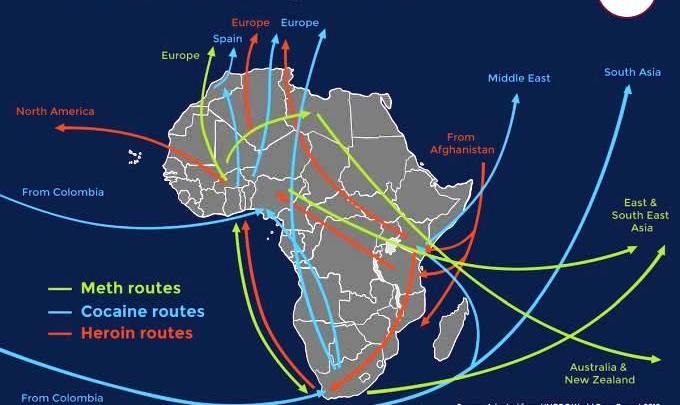
Nigeria, Ethiopia, Tanzania, Kenya, and Uganda are the main transit countries for heroin. West Africa, that of cocaine. Morocco is the kingdom of cannabis.
The African continent has experienced significant increases in drug trafficking in recent years. The reason, in addition to the growing worldwide demand, lies in the ever-increasing fragility of the majority of African states (in particular Somalia, Libya, Guinea-Bissau) in the control of their respective territories and, therefore, in the ability to fight the criminal groups that hold the monopoly of drug trafficking internationally. An example: according to UNODC (United Nations Office for Drug Control and Crime Prevention) data, in 2020-2021 the percentage of cocaine seized in Africa reached around 2% at the world level. However, the demand for this drug has been increasing on the continent in recent years. Even if it remains an inhomogeneous value because the lack of certain data makes it difficult to have a clear
picture of the level of use.
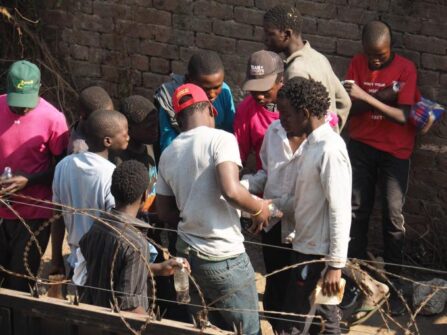
Zimbabwe. Young people. The demand for drugs has been increasing on the continent in recent years. File swm
The basis on which to calculate the importance of Africa in drug trafficking is given by the quantities seized which, according to the UNODC itself, were too low to be true. For cocaine alone, and for West Africa alone, an average of 14.2 tonnes of the drug were seized each year between 2019 and 2022 compared to 5.5 tonnes in 2007 alone.
A note that is by no means irrelevant: according to experts, it is necessary to multiply the seizures by 20 to get an idea of the real amount of drugs trafficked. Since 2019, therefore, approximately 1,140 tonnes of cocaine would have passed through West Africa alone. A market equal to 57 billion euros. This means that annual cocaine trafficking alone accounted for half of Senegal’s GDP, almost all of Niger’s or Guinea’s GDP, and nearly ten times that of Guinea-Bissau.
Heroine and the market
The heroin arrives from Afghanistan, passes through strategic places such as Pakistan, India and Thailand and then reaches East Africa. This would be confirmed by the growing seizures of this substance, in a network that would link Nigeria with East African countries, such as Tanzania, Kenya and Uganda. The main hub for the passage of this narcotic is said to be Addis Ababa airport, followed by that of Nairobi. The available information indicates that Tanzanians and Mozambicans are the subjects most involved in trafficking.
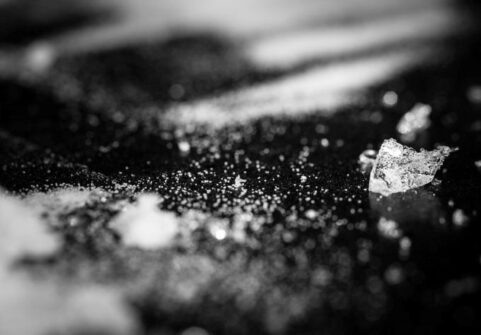
Methamphetamine is produced locally, especially in South Africa. Photo: Pixabay
Heroin reaching East African countries is meant to go directly to European and North American markets, although the African market, especially that of South Africa, has been expanding steadily since 2006. Previously, it was concentrated in tourist resorts, such as Zanzibar, or in cities with a large European presence, such as Johannesburg.
The most travelled route for cocaine continues to be, however, that of the South Atlantic, which penetrates Africa both through South Africa and from the ‘Senegambia’ region, to then leave towards the north. Methamphetamine, on the other hand, is produced locally, especially in South Africa, from which it continues to Europe, with a fairly significant internal consumption. The routes of all three major drugs pass through North Africa, thus underlining the strategic function of this region at an international level.
The East African routes
The East African routes for cannabis pass mainly through ports located in Djibouti, Kenya, Eritrea, and Tanzania, although recent surveys indicate Somalia as the main territory of marketing of this substance, together with arms trafficking. Cannabis comes from Afghanistan, stops in East Africa and from there reaches Western Europe. Cocaine, on the other hand, comes mainly from Latin America.
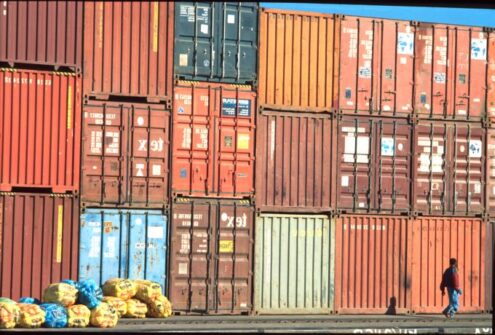
The Port of Dar es Salaam. Containers. Tanzanians and Mozambicans are the subjects most involved in drug trafficking. File swm
Even if an important commercial road has opened up, especially in perspective, on the side of the Indian Ocean, the route of methaqualone – the basis of mandrax, a sedative substance which in the 1970s was used with hypnotic and muscle-relaxing functions – is still that of the east (mostly India, but also China). However, local production has been reported in recent years in African countries that have now become producers and exporters. In 2017, for example, a clandestine mandrax factory, run by a Zambian and four Mozambicans, was seized in southern Mozambique. The mandrax does not usually take western routes but is consumed above all in South Africa (which seems to be the number one world consumer). Local production in neighbouring countries, and without great control by the police, greatly facilitates its disposal.
The Western routes
The history of drug trafficking that passes through West Africa – the so-called Atlantic route – is quite ancient. As early as the 1960s, the expansion of the North American and European markets for cannabis, cocaine and heroin led to a quantum leap in Atlantic trafficking. Two major routes were then formed involving West Africa: one destined for consumption in South Africa, Asia, and Europe. The other, the typically Atlantic one, where cocaine coming from Latin America (especially from Peru and Colombia, via Brazil), together with the oriental one of Afghan heroin, reached Europe and the United States. Almost immediately three countries became the main hubs of these trades: Ghana, Nigeria, and Guinea-Bissau, with the latter defined for a long time as a real ‘narco-state’. According to data from the Global Initiative Against Transnational Organized Crime, the Latin American production of cocaine arriving in West Africa would not have suffered from the stops and controls imposed by Covid-19.
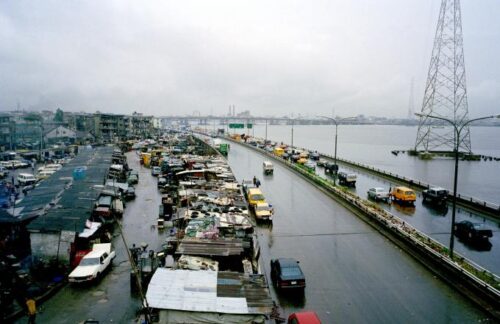
Lagos. The Atlantic Route. Photo: A. Tosatto
This would be confirmed by the quantities seized in recent years, the highest ever on the Atlantic route. According to the latest UNODC report ‘between 2019 and 2022 […] at least 57 tonnes of cocaine were seized in or en route to West Africa, mainly in Cape Verde (16.6 tonnes), Senegal (4.7 tonnes), Benin (3.9 tonnes), Côte d’Ivoire (3.5 tonnes), Gambia (3 tonnes) and Guinea-Bissau (2.7 tonnes)’. 2022 was the year of the mega seizure in Lagos in Nigeria. The Anti-Drug Agency discovered a record 1.8 tons of cocaine, valued at $278 million.
The drugs were found in a warehouse in the Nigerian city. It was the largest seizure ever in the country.
And 2023 began with another important seizure, this time off the Senegalese coast: 805 kg of cocaine were found on January 22 aboard a ‘high seas patrol boat’, 335 km from Dakar, the capital of Senegal.
North African trafficking
North Africa is a territory of production, use and trafficking of various types of drugs. In terms of production, cannabis is the most locally produced substance, with the largest seizures occurring in Egypt and Morocco. 80% of Algerian cannabis is destined for the European market, while 20% is consumed locally. These proportions, according to calculations made by Interpol/Enact (Enhancing Africa’s ability to counter transnational crime) should be valid for the whole area. According to the EMCDDA (European Monitor Centre for Drugs and Drug Addiction) about 1,200 tons of cannabis are needed to satisfy the European market annually, for a total value of about 12 billion euros.
From Morocco, considered the largest producer of cannabis in the world, the routes to reach the European markets, the Middle East and North Africa itself would be those of the sea – via the Strait of Gibraltar – with Spain as the main destination, followed by Italy and France; then the terrestrial route to the south, passing through territories such as Mali, Egypt, Niger and Libya; and the mixed land and sea route, which starts from Morocco and reaches Algeria, Tunisia, Libya and Egypt
along a west-east axis.
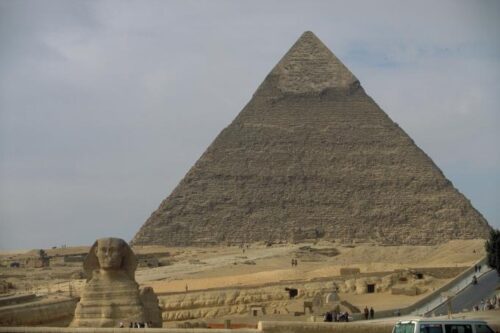
Opium cultivations are known in Egypt and Algeria. File swm
Cocaine from South America represents a growing presence in the North African regions, in transit to Europe. Again, Morocco recorded the most significant seizures by the authorities. An example: the Moroccan authorities recovered, in November 2019, a consignment of 476 kg of cocaine from Colombia hidden in a boat in Temara (south of Rabat, on the Atlantic coast). With regard to heroin, North Africa has a very limited production: opium cultivations are known in Egypt and Algeria, but are not, for the moment, significant. Conversely, the heroin present in the region is imported, mostly from Afghanistan, transiting through Egypt. The route passes through Makran (the coastal part of Balochistan, on the Gulf of Oman), then the Arabian Peninsula, rejoining the Mediterranean via the Red Sea and the Suez Canal, the Red Sea having rediscovered its centrality for these trades. However, the domestic use of heroin in Egypt is also notable, and is, according to local authorities, the second or third most commonly used narcotic substance locally. This is also why the largest quantities of heroin were recovered in the shadow of the pyramids. Little was discovered in the other countries of the area. Among other drugs, tramadol – originating from India and Sri Lanka – passes essentially through Egypt (where it is also consumed) and Libya. Recently, a type of tramadol of Chinese origin has also been discovered. Italy is strategically important for its sale, especially in the ports of Genoa and Gioia Tauro, with interconnections between local and North African mafias, especially those of Libya. (L. B.) (Map: Enact)



